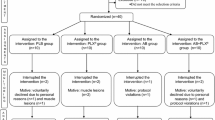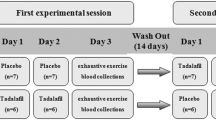Abstract
The aim of this study was to follow up whether the modification of pro-antioxidant status by 8-day oral application of N-acetylcysteine (NAC) in healthy men affects the haematological response, whether there is a direct relationship between antioxidant defences and erythropoietin (EPO) secretion and whether NAC intake enhances exercise performance. Fifteen healthy men were randomly assigned to one of two groups: control or NAC (1,200 mg d−1 for 8 days prior to and 600 mg on the day of exercise trial). To measure the ergogenic effectiveness of NAC, subjects performed incremental cycle exercise until exhaustion. NAC administration significantly influenced the resting and post-exercise level of glutathione (+31%) as well as the resting activity of glutathione enzymes (glutathione reductase, −22%; glutathione peroxidase, −18%). The oxidative damage markers, i.e., protein carbonylation and lipid peroxidation products (thiobarbituric acid reactive substance) were reduced by NAC by more than 30%. NAC noticeably affected the plasma level of EPO (+26%), haemoglobin (+9%), haematocrit (+9%) and erythrocytes (−6%) at rest and after exercise. The mean corpuscular volume and the mean corpuscular haemoglobin increased by more than 12%. Plasma total thiols increased by 17% and directly correlated with EPO level (r = 0.528, P < 0.05). NAC treatment, contrary to expectations, did not significantly affect exercise performance. Our study has shown that 8-day NAC intake at a daily dose of 1,200 mg favours a pro-antioxidant status and affects haematological indices but does not enhance exercise performance.

Similar content being viewed by others
References
Kerksick C, Willoughby D (2005) The antioxidant role of glutathione and N-acetylcysteine supplements and exercise-induced oxidative stress. J Int Soc Sports Nutr 2:38–44
Sen CK, Packer L (2000) Thiol homeostasis and supplements in physical exercise. Am J Clin Nutr 72:653–669
Medved I, Brown MJ, Bjorksten AR, Leppik JA, Sostaric S, McKenna MJ (2003) N-acetylcysteine infusion alters blood redox status but not time to fatigue during intense exercise in humans. J Appl Physiol 94:1572–1582
Sen CK, Rankinen T, Vaisanen S, Rauramaa R (1994) Oxidative stress after exercise: effect of N-acetylcysteine supplementation. J Appl Physiol 76:2570–2577
Childs A, Jacobs C, Kaminski T, Halliwell B, Leeuwenburgh C (2001) Supplementation with vitamin C and N-acetylcysteine increases oxidative stress in humans after an acute muscle injury induced by eccentric exercise. Free Rad Biol Med 31:745–753
Kleinveld HA, Demacker PN, Stalenhoef AF (1992) Failure of N-acetylcysteine to reduce low-density lipoprotein oxidizability in healthy subjects. Eur J Clin Pharmacol 43:639–642
Nagata M, Arimitsu N, Ito T, Sekimizu K (2007) Antioxidant N-acetylcysteine inhibits erythropoietin-induced differentation of erythroid progenitors derived from mouse fetal liver. Cell Biol Int 31:252–256
Hildebrandt W, Alexander S, Bärtsch P, Dröge W (2002) Effect of N-acetylcysteine on the hypoxic ventilatory response and erythropoietin production: linkage between plasma thiol redox state and O2 chemosensitivy. Blood 99:1552–1555
Freudenthaler SM, Schreeb KH, Wiese A, Pilz J, Gleiter CH (2002) Influence of controlled hypoxia and radical scavenging agents on erythropoietin and malondialdehyde concentrations in humans. Acta Physiol Scand 174:231–235
Matuszczak Y, Farid M, Jones J, Lansdowne S, Smith MA, Taylor AA (2005) Effects of N-acetylcysteine on glutathione oxidation and fatigue during handgrip exercise. Muscle Nerve 32:633–638
Medved I, Brown MJ, Bjorksten AR, McKenna MJ (2004) Effects of intravenous N-acetylcysteine infusion on time to fatigue and potassium regulation during prolonged cycling exercise. J Appl Physiol 96:211–217
Reid MB, Stokic DS, Koch SM, Khawli FA, Leis AA (1994) N-acetylcysteine inhibits muscle fatigue in humans. J Clin Invest 94:2468–2474
Beutler E, Duron O, Mikus KB (1963) Improved method for determination of blood glutathione. J Lab Clin Med 61:882–888
Levine RL, Garland D, Oliver CN (1990) Determination of carbonyl content in oxidatively modified proteins. Methods Enzymol 186:464–479
Bradford MM (1976) A rapid and sensitive method for the quantitation of microgram quantities of protein utilizing the principle of protein-dye binding. Anal Biochem 72:248–254
Buege J, Aust SD (1991) The thiobarbituric acid assay. In: Rice-Evans CA, Diplock AT, Symons MCR (eds) Techniques in Free Radical Research. Elsevier, Amsterdam, pp 147–148
Hebeeb AFSA (1972) Reaction of protein sulfhydryl groups with Ellman’s reagent. Methods Enzymol 25:457–464
Strauss MB, Davis RK, Rosenbaum JD, Rossmeisl EC (1951) Water diuresis produced during recumbency by the intravenous infusion of isotonic saline solution. J Clin Invest 30:862–868
Kraemer RR, Brown BS (1986) Alternations in plasma-volume-corrected blood components of marathon runners and concomitant relationship to performance. Eur J Appl Physiol 55:579–584
Sexton DJ, Mutus B (1992) Glutathione reductases from a variety are inhibited by physiological levels of glutathione. Comp Biochem Physiol 103:897–901
Vesovic D, Borjanovic S, Markovic S, Vidakovic A (2002) Strenuous exercise and action of antioxidant enzymes. La Med Lav 93:540–550
Kelly GS (1998) Clinical applications of N-acetylcysteine. Altern Med Rev 3:114–127
Winterbourn CC, Peskin AV, Parsons-Mair HN (2002) Thiol oxidase activity of copper, zinc superoxide dismutase. J Biol Chem 277:1906–1911
Fandrey J, Frede S, Jelkmann W (1994) Role of hydrogen peroxide in hypoxia-induced erythropoietin production. Biochem J 303:507–510
Huang LE, Arany Z, Livingston DM, Bunn HF (1996) Activation of hypoxia-inducible transcription factor depends primarily upon redox-sensitive stabilization of its α-subunit. J Biol Chem 271:32253–32259
Jelkmann W, Pagel H, Hellwig T, Fandrey J (1997) Effects of antioxidant vitamins on renal and hepatic erythropoietin production. Kidney Int 51:497–501
Niess AM, Fehrenbach E, Lorenz I, Müller A, Northoff H, Dickhuth HH (2004) Antioxidant intervention does not affect the response of plasma erythropoietin to short-term normobaric hypoxia in humans. J Appl Physiol 96:1231–1235
Senturk UK, Yalcin O, Gunduz F, Kuru O, Meiselman HJ, Baskurt OK (2005) Effect of antioxidant vitamin treatment on the time course of hematological and hemorheological alterations after an exhausting exercise episode in human subjects. J Appl Physiol 98:1272–1279
Zhang ZG, Xu P, Liu Q, Yu CH, Zhang Y, Chen SH (2006) Effect of tea polyphenols on cytokine gene expression in rats with alcoholic liver disease. Hepatobiliary Pancreat Dis Int 6:268–272
Acknowledgements
We thank Prof. Wolfgang Jelkmann for the helpful discussion and critical comments on the manuscript. This study was supported by grant for research from University of Physical Education Poznan, Poland.
Author information
Authors and Affiliations
Corresponding author
Additional information
A. ZEMBRON-LACNY, M. SLOWINSKA-LISOWSKA, Z. SZYGULA, K. WITKOWSKI and Z. SZYSZKA. Modulatory effect of N-acetylcysteine on pro-antioxidant status and haematological response in healthy men. J Physiol Biochem, 66 (1), 000-000, 2010.
Rights and permissions
About this article
Cite this article
Zembron-Lacny, A., Slowinska-Lisowska, M., Szygula, Z. et al. Modulatory effect of N-acetylcysteine on pro-antioxidant status and haematological response in healthy men. J Physiol Biochem 66, 15–21 (2010). https://doi.org/10.1007/s13105-010-0002-1
Received:
Accepted:
Published:
Issue Date:
DOI: https://doi.org/10.1007/s13105-010-0002-1




